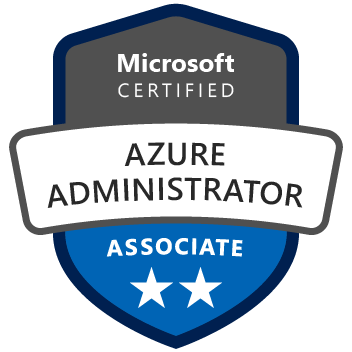
Students will learn to implement, manage, and monitor a Microsoft Azure environment, which includes virtual networks, storage, compute, identity, security, and governance.
Azure administrators typically work as part of a larger team dedicated to implementing an organization’s cloud infrastructure, collaborating with other roles to deliver Azure networking, security, database, application development, and DevOps solutions.
Skills taught:
Manage Azure identities and governance (20–25%):
- Manage Microsoft Entra users and groups
- Create users and groups
- Manage user and group properties
- Manage licenses in Microsoft Entra ID
- Manage external users
- Configure self-service password reset (SSPR)
- Manage access to Azure resources
- Manage built-in Azure roles
- Assign roles at different scopes
- Interpret access assignments
- Manage Azure subscriptions and governance
- Implement and manage Azure Policy
- Configure resource locks
- Apply and manage tags on resources
- Manage resource groups
- Manage subscriptions
- Manage costs using alerts, budgets, and Azure Advisor recommendations
- Configure management groups
Implement and manage storage (15–20%):
- Configure access to storage
- Configure Azure Storage firewalls and virtual networks
- Create and use shared access signature (SAS) tokens
- Configure stored access policies
- Manage access keys
- Configure identity-based access for Azure Files
- Configure and manage storage accounts
- Create and configure storage accounts
- Configure Azure Storage redundancy
- Configure object replication
- Configure storage account encryption
- Manage data using Azure Storage Explorer and AzCopy
- Configure Azure Files and Azure Blob Storage
- Create and configure a file share in Azure Storage
- Create and configure a container in Blob Storage
- Configure storage tiers
- Configure snapshots and soft delete for Azure Files
- Configure blob lifecycle management
- Configure blob versioning
Deploy and manage Azure compute resources (20–25%):
- Automate deployment of resources using Azure Resource Manager (ARM) templates or Bicep files
- Interpret an Azure Resource Manager template or a Bicep file
- Modify an existing Azure Resource Manager template
- Modify an existing Bicep file
- Deploy resources using an Azure Resource Manager template or a Bicep file
- Export a deployment as an Azure Resource Manager template or convert an Azure Resource Manager template to a Bicep file
- Create and configure virtual machines
- Create a virtual machine
- Configure Azure Disk Encryption
- Move a virtual machine to another resource group, subscription, or region
- Manage virtual machine sizes
- Manage virtual machine disks
- Deploy virtual machines to availability zones and availability sets
- Deploy and configure an Azure Virtual Machine Scale Sets
- Provision and manage containers in the Azure portal
- Create and manage an Azure container registry
- Provision a container using Azure Container Instances
- Provision a container using Azure Container Apps
- Manage sizing and scaling for containers, including Azure Container Instances and Azure Container Apps
- Create and configure Azure App Service
- Provision an App Service plan
- Configure scaling for an App Service plan
- Create an App Service
- Configure certificates and Transport Layer Security (TLS) for an App Service
- Map an existing custom DNS name to an App Service
- Configure backup for an App Service
- Configure networking settings for an App Service
- Configure deployment slots for an App Service
Implement and manage virtual networking (15–20%):
- Configure and manage virtual networks in Azure
- Create and configure virtual networks and subnets
- Create and configure virtual network peering
- Configure public IP addresses
- Configure user-defined network routes
- Troubleshoot network connectivity
- Configure secure access to virtual networks
- Create and configure network security groups (NSGs) and application security groups
- Evaluate effective security rules in NSGs
- Implement Azure Bastion
- Configure service endpoints for Azure platform as a service (PaaS)
- Configure private endpoints for Azure PaaS
- Configure name resolution and load balancing
- Configure Azure DNS
- Configure an internal or public load balancer
- Troubleshoot load balancing
Monitor and maintain Azure resources (10–15%):
- Monitor resources in Azure
- Interpret metrics in Azure Monitor
- Configure log settings in Azure Monitor
- Query and analyze logs in Azure Monitor
- Set up alert rules, action groups, and alert processing rules in Azure Monitor
- Configure and interpret monitoring of virtual machines, storage accounts, and networks using Azure Monitor Insights
- Use Azure Network Watcher and Connection Monitor
- Implement backup and recovery
- Create a Recovery Services vault
- Create an Azure Backup vault
- Create and configure a backup policy
- Perform backup and restore operations using Azure Backup
- Configure Azure Site Recovery for Azure resources
- Perform a failover to a secondary region using Site Recovery
- Configure and interpret reports and alerts for backups